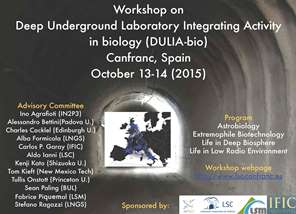Description
New Mexico State University-Department of Biology, Las Cruces, New Mexico, USA
The LBRE project was initiated in 2009 at the U.S. Waste Isolation Pilot Plant (WIPP) taking advantage of the shielding provided by the 650 m deep repository, with the objective to study the response of cells to radiation doses from the “other side of background.” Added to the natural low-rad nature due to the salt composition of the Salado formation, is the use of a pre-World War II steel vault which allows us to reduce background radiation by an approximate factor of 400 (down to 0.2 nGy/hr), as modeled by Monte Carlo N-Particle (MCNP) analyses. We have employed two types of controls in which cells are exposed to normal, background levels of radiation: they are grown aboveground (Smith et al. 2011) or they are grown underground with a natural source (KCl) of radiation added back to approximate background levels. For comparative purposes we have developed a system to test low levels of above background radiation by deploying an array of 60Co coupons to monitor low level radiation above background. Initial results suggest that below background levels are more stressful than above background levels. Results also indicate that when deprived of natural levels of radiation, the radiation sensitive bacterium, Shewanella oneidensis, up-regulates the expression of genes belonging to three different families of stress response genes for DNA repair, reactive oxygen stress (ROS) scavenging and metal efflux pumps. After documenting the stress response, when we return the cells to radiation-sufficient conditions, the stress is allayed and the cells return to normal, control levels of gene expression and growth (Castillo et al. 2015). We have recently expanded our screening capabilities with next-generation sequencing to study the genome-wide response (transcriptome analysis) with an RNA-Seq approach. Preliminary data shows the differential regulation of 272 and 172 known-function genes in both S. oneidensis and D. radiodurans, respectively, in response to radiation deprivation. As an example, S. oneidensis patterns of gene expression suggest that radiation-shielding at WIPP increases the transcription of genes related to protein synthesis, signal transduction and transport processes while decreasing the transcription of genes involved in protein assembly.

